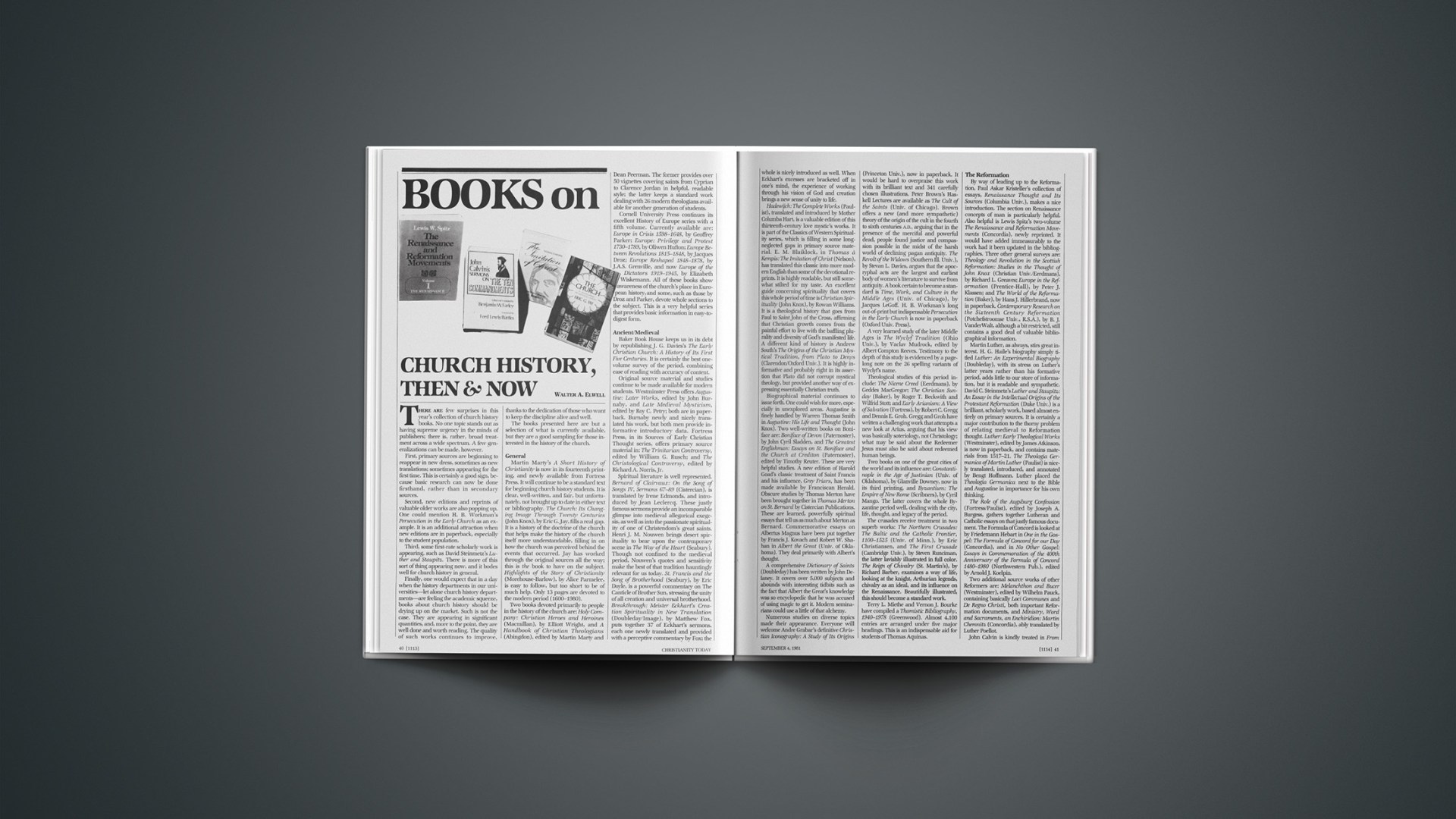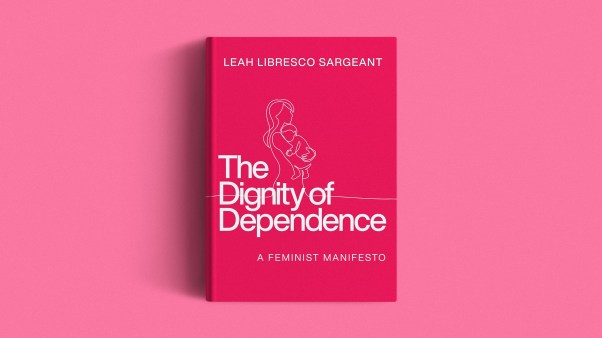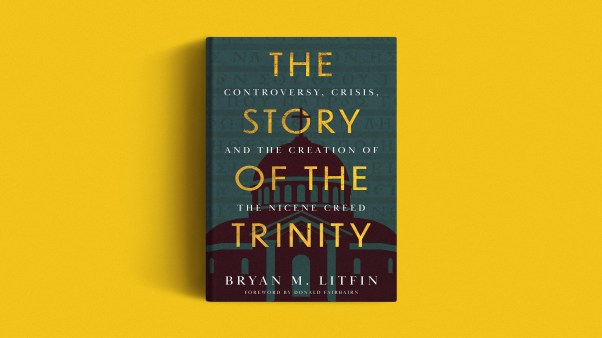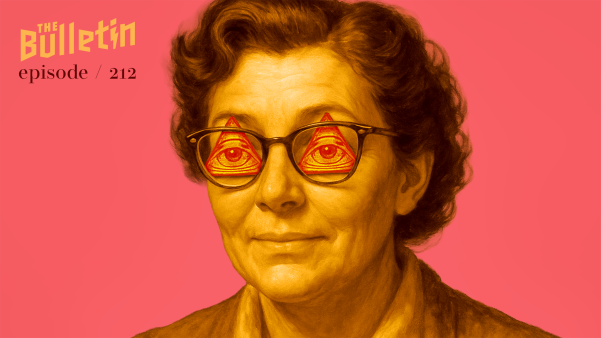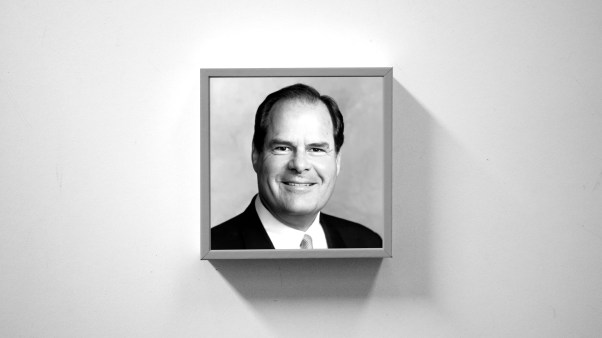There are few surprises in this year’s collection of church history books. No one topic stands out as having supreme urgency in the minds of publishers; there is, rather, broad treatment across a wide spectrum. A few generalizations can be made, however.
First, primary sources are beginning to reappear in new dress, sometimes as new translations; sometimes appearing for the first time. This is certainly a good sign, because basic research can now be done firsthand, rather than in secondary sources.
Second, new editions and reprints of valuable older works are also popping up. One could mention H. B. Workman’s Persecution in the Early Church as an example. It is an additional attraction when new editions are in paperback, especially to the student population.
Third, some first-rate scholarly work is appearing, such as David Steinmetz’s Luther and Staupitz. There is more of this sort of thing appearing now, and it bodes well for church history in general.
Finally, one would expect that in a day when the history departments in our universities—let alone church history departments—are feeling the academic squeeze, books about church history should be drying up on the market. Such is not the case. They are appearing in significant quantities, and, more to the point, they are well done and worth reading. The quality of such works continues to improve, thanks to the dedication of those who want to keep the discipline alive and well.
The books presented here are but a selection of what is currently available, but they are a good sampling for those interested in the history of the church.
General
Martin Marty’s A Short History of Christianity is now in its fourteenth printing, and newly available from Fortress Press. It will continue to be a standard text for beginning church history students. It is clear, well-written, and fair, but unfortunately, not brought up to date in either text or bibliography. The Church: Its Changing Image Through Twenty Centuries (John Knox), by Eric G. Jay, fills a real gap. It is a history of the doctrine of the church that helps make the history of the church itself more understandable, filling in on how the church was perceived behind the events that occurred. Jay has worked through the original sources all the way; this is the book to have on the subject. Highlights of the Story of Christianity (Morehouse-Barlow), by Alice Parmelee, is easy to follow, but too short to be of much help. Only 13 pages are devoted to the modern period (1600–1980).
Two books devoted primarily to people in the history of the church are: Holy Company: Christian Heroes and Heroines (Macmillan), by Elliott Wright, and A Handbook of Christian Theologians (Abingdon), edited by Martin Marty and Dean Peerman. The former provides over 50 vignettes covering saints from Cyprian to Clarence Jordan in helpful, readable style; the latter keeps a standard work dealing with 26 modern theologians available for another generation of students.
Cornell University Press continues its excellent History of Europe series with a fifth volume. Currently available are: Europe in Crisis 1598–1648, by Geoffrey Parker; Europe: Privilege and Protest 1730–1789, by Oliwen Hufton; Europe Between Revolutions 1815–1848, by Jacques Droz; Europe Reshaped 1848–1878, by J.A.S. Grenville, and now Europe of the Dictators 1919–1945, by Elizabeth Wiskemann. All of these books show awareness of the church’s place in European history, and some, such as those by Droz and Parker, devote whole sections to the subject. This is a very helpful series that provides basic information in easy-to-digest form.
Ancient/Medieval
Baker Book House keeps us in its debt by republishing J. G. Davies’s The Early Christian Church: A History of Its First Five Centuries. It is certainly the best one-volume survey of the period, combining ease of reading with accuracy of content.
Original source material and studies continue to be made available for modern students. Westminster Press offers Augustine: Later Works, edited by John Burnaby, and Late Medieval Mysticism, edited by Roy C. Petry; both are in paperback. Burnaby newly and nicely translated his work, but both men provide informative introductory data. Fortress Press, in its Sources of Early Christian Thought series, offers primary source material in: The Trinitarian Controversy, edited by William G. Rusch; and The Christological Controversy, edited by Richard A. Norris, Jr.
Spiritual literature is well represented. Bernard of Clairvaux: On the Song of Songs IV, Sermons 67–89 (Cistercian), is translated by Irene Edmonds, and introduced by Jean Leclercq. These justly famous sermons provide an incomparable glimpse into medieval allegorical exegesis, as well as into the passionate spirituality of one of Christendom’s great saints. Henri J. M. Nouwen brings desert spirituality to bear upon the contemporary scene in The Way of the Heart (Seabury). Though not confined to the medieval period, Nouwen’s quotes and sensitivity make the best of that tradition hauntingly relevant for us today. St. Francis and the Song of Brotherhood (Seabury), by Eric Doyle, is a powerful commentary on The Canticle of Brother Sun, stressing the unity of all creation and universal brotherhood. Breakthrough: Meister Eckhart’s Creation Spirituality in New Translation (Doubleday/Image), by Matthew Fox, puts together 37 of Eckhart’s sermons, each one newly translated and provided with a perceptive commentary by Fox; the whole is nicely introduced as well. When Eckhart’s excesses are bracketed off in one’s mind, the experience of working through his vision of God and creation brings a new sense of unity to life.
Hadeijch: The Complete Works (Paulist), translated and introduced by Mother Columba Hart, is a valuable edition of this thirteenth-century love mystic’s works. It is part of the Classics of Western Spirituality series, which is filling in some long-neglected gaps in primary source material. E. M. Blaiklock, in Thomas à Kempis: The Imitation of Christ (Nelson), has translated this classic into more modern English than some of the devotional reprints. It is highly readable, but still somewhat stilted for my taste. An excellent guide concerning spirituality that covers this whole period of time is Christian Spirituality (John Knox), by Rowan Williams. It is a theological history that goes from Paul to Saint John of the Cross, affirming that Christian growth comes from the painful effort to live with the baffling plurality and diversity of God’s manifested life. A different kind of history is Andrew South’s The Origins of the Christian Mystical Tradition, from Plato to Denys (Clarendon/Oxford Univ.). It is highly informative and probably right in its assertion that Plato did not corrupt mystical theology, but provided another way of expressing essentially Christian truth.
Biographical material continues to issue forth. One could wish for more, especially in unexplored areas. Augustine is finely handled by Warren Thomas Smith in Augustine: His Life and Thought (John Knox). Two well-written books on Boniface are: Boniface of Devon (Paternoster), by John Cyril Sladden, and The Greatest Englishman: Essays on St. Boniface and the Church at Crediton (Paternoster), edited by Timothy Reuter. These are very helpful studies. A new edition of Harold Goad’s classic treatment of Saint Francis and his influence, Grey Friars, has been made available by Franciscan Herald. Obscure studies by Thomas Merton have been brought together in Thomas Merton on St. Bernard by Cistercian Publications. These are learned, powerfully spiritual essays that tell us as much about Merton as Bernard. Commemorative essays on Albertus Magnus have been put together by Francis J. Kovach and Robert W. Shahan in Albert the Great (Univ. of Oklahoma). They deal primarily with Albert’s thought.
A comprehensive Dictionary of Saints (Doubleday) has been written by John Delaney. It covers over 5,000 subjects and abounds with interesting tidbits such as the fact that Albert the Great’s knowledge was so encyclopedic that he was accused of using magic to get it. Modern seminarians could use a little of that alchemy.
Numerous studies on diverse topics made their appearance. Everyone will welcome Andre Grabar’s definitive Christian Iconography: A Study of Its Origins (Princeton Univ.), now in paperback. It would be hard to overpraise this work with its brilliant text and 341 carefully chosen illustrations. Peter Brown’s Haskell Lectures are available as The Cult of the Saints (Univ. of Chicago). Brown offers a new (and more sympathetic) theory of the origin of the cult in the fourth to sixth centuries A.D., arguing that in the presence of the merciful and powerful dead, people found justice and compassion possible in the midst of the harsh world of declining pagan antiquity. The Revolt of the Widows (Southern Ill. Univ.), by Stevan L. Davies, argues that the apocryphal acts are the largest and earliest body of women’s literature to survive from antiquity. A book certain to become a standard is Time, Work, and Culture in the Middle Ages (Univ. of Chicago), by Jacques LeGoff. H. B. Workman’s long out-of-print but indispensable Persecution in the Early Church is now in paperback (Oxford Univ. Press).
A very learned study of the later Middle Ages is The Wyclyf Tradition (Ohio Univ.), by Vaclav Mudrock, edited by Albert Compton Reeves. Testimony to the depth of this study is evidenced by a page-long note on the 26 spelling variants of Wyclyf’s name.
Theological studies of this period include: The Nicene Creed (Eerdmans), by Geddes MacGregor; The Christian Sunday (Baker), by Roger T. Beckwith and Wilfrid Stott; and Early Arianism: A View of Salvation (Fortress), by Robert C. Gregg and Dennis E. Groh. Gregg and Groh have written a challenging work that attempts a new look at Arius, arguing that his view was basically soteriology, not Christology; what may be said about the Redeemer Jesus must also be said about redeemed human beings.
Two books on one of the great cities of the world and its influence are: Constantinople in the Age of Justinian (Univ. of Oklahoma), by Glanville Downey, now in its third printing, and Byzantium: The Empire of New Rome (Scribners), by Cyril Mango. The latter covers the whole Byzantine period well, dealing with the city, life, thought, and legacy of the period.
The crusades receive treatment in two superb works: The Northern Crusades: The Baltic and the Catholic Frontier, 1100–1525 (Univ. of Minn.), by Eric Christiansen, and The First Crusade (Cambridge Univ.), by Steven Runciman, the latter lavishly illustrated in full color. The Reign of Chivalry (St. Martin’s), by Richard Barber, examines a way of life, looking at the knight, Arthurian legends, chivalry as an ideal, and its influence on the Renaissance. Beautifully illustrated, this should become a standard work.
Terry L. Miethe and Vernon J. Bourke have compiled a Thomistic Bibliography, 1940–1978 (Greenwood). Almost 4,100 entries are arranged under five major headings. This is an indispensable aid for students of Thomas Aquinas.
The Reformation
By way of leading up to the Reformation, Paul Askar Kristeller’s collection of essays, Renaissance Thought and Its Sources (Columbia Univ.), makes a nice introduction. The section on Renaissance concepts of man is particularly helpful. Also helpful is Lewis Spitz’s two-volume The Renaissance and Reformation Movements (Concordia), newly reprinted. It would have added immeasurably to the work had it been updated in the bibliographies. Three other general surveys are: Theology and Revolution in the Scottish Reformation: Studies in the Thought of John Knox (Christian Univ./Eerdmans), by Richard L. Greaves; Europe in the Reformation (Prentice-Hall), by Peter J. Klassen; and The World of the Reformation (Baker), by Hans J. Hillerbrand, now in paperback. Contemporary Research on the Sixteenth Century Reformation (Potchefstroomse Univ., R.S.A.), by B. J. Vander Walt, although a bit restricted, still contains a good deal of valuable bibliographical information.
Martin Luther, as always, stirs great interest. H. G. Haile’s biography simply titled Luther: An Experimental Biography (Doubleday), with its stress on Luther’s latter years rather than his formative period, adds little to our store of information, but it is readable and sympathetic. David C. Steinmetz’s Luther and Staupitz: An Essay in the Intellectual Origins of the Protestant Reformation (Duke Univ.) is a brilliant, scholarly work, based almost entirely on primary sources. It is certainly a major contribution to the thorny problem of relating medieval to Reformation thought. Luther: Early Theological Works (Westminster), edited by James Atkinson, is now in paperback, and contains materials from 1517–21. The Theologia Germanica of Martin Luther (Paulist) is nicely translated, introduced, and annotated by Bengt Hoffmann. Luther placed the Theologia Germanica next to the Bible and Augustine in importance for his own thinking.
The Role of the Augsburg Confession (Fortress/Paulist), edited by Joseph A. Burgess, gathers together Lutheran and Catholic essays on that justly famous document. The Formula of Concord is looked at by Friedemann Hebart in One in the Gospel: The Formula of Concord for our Day (Concordia), and in No Other Gospel: Essays in Commemoration of the 400th Anniversary of the Formula of Concord 1480–1980 (Northwestern Pub.), edited by Arnold J. Koelpin.
Two additional source works of other Reformers are: Melanchthon and Bucer (Westminster), edited by Wilhelm Pauck, containing basically Loci Communes and De Regno Christi, both important Reformation documents, and Ministry, Word and Sacraments, an Enchiridion: Martin Chemnitz (Concordia), ably translated by Luther Poellot.
John Calvin is kindly treated in FromNoyon to Geneva (Potchefstroom Univ., R.S.A.), by B. J. vanderWalt. This illustrated pilgrimage in the steps of Calvin would serve as an excellent guide for anyone wishing to take the same trip. This Was John Calvin (Baker), by Thea B. Van Halsema, is now in paperback and called by Roger Nicole “the most lively and readable biography of Calvin available in English.” Ford Lewis Battles’s Analysis of the Institutes of the Christian Religion of John Calvin (Baker) makes a handy guide and summary of Calvin’s massive work. Calvin’s Sermons on the Saving Work of Christ (Baker), translated by Leroy Nixon, is now available in paperback, and his Sermons on the Ten Commandments (Baker) have been translated by Benjamin W. Farley, making this the only available collection in English. The last edition appeared in 1583.
A very readable biography of William Tyndale is God’s Outlaw (Tyndale), by Brian Edwards. It is a thrilling story, well told. Certain to be a major work in the history of covenant theology is Heinrich Bullinger and the Covenant (Ohio Univ.), by J. Wayne Baker. It is an erudite work whose notes and bibliographies (over 70 pages) are worth the price of the book.
The so-called radical reformation is beginning to attract new scholarly interest. The Golden Years of the Hutterites (Herald), by Leonard Gross, covers the years 1565–78 in masterful fashion. It is written the way history ought to be written. The Reformers and Their Stepchildren (Baker), by Leonard Verduin, is now in paperback and rightly so, covering as it does a much neglected aspect of Reformation history: the secondary, radical Reformers. The Writings of Pilgrim Marpeck (Herald), translated and edited by William Klassen and Walter Klaassen, continue the Classics of the Radical Reformation series, adding to our store of primary source material.
Volume two of Oskar Garstein’s formidable history, Rome and the Counter-Reformation in Scandinavia (1583–1622), has been made available by the Universitetsforlaget, Oslo. It is the definitive work on the subject and contains a veritable mine of information; notes, bibliography, and index cover over 200 pages.
Erasmus on His Times (Cambridge Univ.), by Margaret Mann Phillips, is a shortened version of The Adages and is now available in paperback. John Eck’s Enchiridion of Commonplaces Against Luther and Other Enemies of the Church has been translated by Ford Lewis Battles and published by Baker. It is the only English translation available.
British Church History
A general survey of Christianity in England from early Roman times to the break with Rome is Christian England: Its Story to the Reformation (Oxford Univ.), by David L. Edwards. It is the best one-volume guide to this period available. It would be difficult to exaggerate the brilliance of Christianity in Roman Britain to A.D. 500 (Univ. of California), by Charles Thomas. His use of archaeology is especially helpful, as he shows the continuous nature of Britain’s Christian history as against those who argue for a radical break after the Roman period.
Three new books about the Elizabethan era appeared: Elizabeth Regina: The Age of Triumph 1588–1603 (Times Books), by Alison Plowden, a well-done treatment of the golden age of Elizabeth; The Making of Elizabethan Foreign Policy 1558–1603 (Univ. of Calif.), by R. B. Wemham, an all-too-brief look at a very important topic; and The Cambridge Connection and the Elizabethan Settlement of 1559 (Duke Univ.), by Winthrop S. Hudson, a challenging new look at the political factors leading up to the settlement.
Seventeenth-century studies will be greatly enhanced by J. S. Morrill’s Seventeenth Century Britain: 1603–1714 (Archon), which is a neatly annotated bibliography of over 1,300 titles, divided into 11 subjects, including ecclesiastical history. Government by Pen: Scotland Under James VI and I (Univ. of Ill.), by Maurice Lee, is a detailed history that will likely take its place as one of the best studies of this significant king. From Tradition to Political Reality (Archon), by Margaret A. Judson, is a study of the arguments used to support the idea of commonwealth government in England from 1649–53.
The Faith of John Dryaen: Change and Continuity (Univ. of Kentucky), by G. Douglas Atkins, offers a well-argued new interpretation of Dryden’s celebrated conversion to Catholicism. A marvelous work, long out of print, is available again in Nicholas Ferrar of Little Gidding (Eerdmans), by A. L. Maycock. Ferrar’s remarkable life and work make inspiring reading for all socially alert Christians. John Donne: Life, Mind and Art (Oxford Univ.), by John Carey, works through a set of themes in Donne’s thought, such as death, change, bodies, and ambitions. It is a highly informative and literate treatment of the poet’s distinctive contribution. John Bunvan’s 1660 tract Prayer has been reprinted by Gospel Mission Press, 406 S. Main St., Choteau, Montana.
The Sword of the Spirit (Univ. of Chicago), by John R. Knott, Jr., traces the development of Puritan spirituality by looking at the use of biblical themes and images in Sibbes, Baxter, Winstanley, Milton, and Bunyan. A biographical look is taken at Alexander Henderson, Samuel Rutherford, John Bunyan, and Richard Baxter in Makers of Puritan History (Baker), by Marcus Loane, appearing now in paperback. R. T. Kendall’s epoch-making Calvin and English Calvinism to 1649 (Oxford Univ.) is also now available in paperback. A neglected aspect of this period is carefully treated by Joyce Oldham Appleby in Economic Thought and Ideology in Seventeenth-Century England (Princeton Univ.).
An excellent survey covering the whole period from the fifteenth century to the 1780s is Angus Calder’s Revolutionary Empire (Dutton). This massive and detailed work will no doubt become the standard text for this era.
A few new items, mostly biographical, concern the eighteenth century. Amazing Grace (Harper & Row), by John Pollock, is a snappy treatment of the intriguing John Newton, based on his journals. John Newton: His Autobiography (Moody) is the well-known collection of 14 letters that describe in detail Newton’s life. Adam Smith: The Man and His Works (Liberty), by E. G. West, rehearses the basic facts of his life nicely.
William Law (Twayne/G. K. Hall), by Erwin Paul Rudolph, looks at Law as a writer and mystic. Rudolph has also edited William Law: On Christian Perfection (Bethany Fellowship), Law’s classic devotional work.
The Radical Wesley and Patterns for Church Renewal (InterVarsity), by Howard A. Snyder, looks at the revolutionary principles Wesley embodied and ways they can apply today. Everyone, but especially Baptists, will be happy to see Thomas Crosby’s The History of the English Baptists, from the Reformation to the Beginning of the Reign of King George I, four volumes in two; and The American Baptist Heritage in Wales, which is a history of the Baptist churches in Wales and a biography of Joshua Thomas by Eric W. Hayden, available from the Primitive Baptist Library, 107 Elm Lane, Streamwood, Illinois. Students of Baptist history cannot do without this primary source material.
The nineteenth century received slightly more attention. Robert Murray McCheyne’s A Basket of Fragments (Christian Focus, Henderson Rd., Inverness IVI ISP, U.K.) is available again, after approximately 125 years. These powerful sermons were preached mainly in the 1840s. Three new books deal with Newman, who is always a subject of discussion: The Spirituality of John Henry Newman (Winston), by C. S. Dessain, a topical study of Newman’s basic stance that stresses wholeness; Newman and the Gospel of Christ (Oxford Univ.), by Roderick Strange, a masterful treatment of Newman’s Christology; and Doubt and Religious Commitment (Clarendon/Oxford), by M. Jamie Ferreira, a study of the will in Newman’s thought.
The unabridged version of Spurgeon’s Lectures to My Students has been newly printed by Zondervan. This perennial favorite continues to attract attention. Al Bryant has put together a year’s readings drawn from Spurgeon’s writings in Near the Sun (Word). It is fine devotional reading.
Robert M. Polhemus has written an incisive Comic Faith (Univ. of Chicago). It analyzes the comic tradition from Austin to Joyce, reminding us that “Comedy is an escape not from truth, but from despair: a narrow escape into faith” (Christopher Fry). Victorian Types, Victorian Shadows(Routledge & Kegan Paul), by George P. Landow, is a scholarly study of biblical typology in Victorian literature, art, and thought. It certainly must be the best available book on this topic. The Peculiar People (Paternoster), by Mark Sorrell, is a fascinating history of a revivalist movement in Essex during the nineteenth century known today as the Union of Evangelical Churches. A highly instructive collection of essays is Benson of Cowley (Oxford Univ.), edited by Martin Smith, which is about one of England’s greatest nineteenth-century spiritual giants. A very well-done biography is Hilaire Belloc: Edwardian Radical (Liberty), by John P. McCarthy. A friend of G. K. Chesterton, Christian apologist Belloc spoke sharply to his generation. That may be seen in Belloc’s The Servile State, made available in a new edition, also by Liberty Press.
Two books that ought to be read side by side are: In Retrospect: Remembrance of Things Past (Eerdmans), by F. F. Bruce, and The Roots of a Radical (Crossroads), by John A. T. Robinson. These two contemporary autobiographies cover the same territory but could not be more different in their perceptions of what has taken place in the last 25 years. Both contain great insight, and challenge readers to look again at where we are headed. John Hick has an autobiographical section in his latest work, God Has Many Names (Humanities Press, Atlantic Highlands, N.J.), which could profitably be read alongside these two larger works.
U.S. Church History
Some interesting material has appeared that deals with the early period. A complete study of Thomas Hooker’s works is The Writings of Thomas Hooker: Spiritual Adventure in Two Worlds (Univ. of Wisconsin), by Sargent Bush, Jr. It is the finest and most comprehensive treatment to date. The Language of Canaan (Harvard Univ.), by Mason I. Lowance, Jr., is a masterful study of metaphor and symbol in New England thought from the earliest period to Emerson and Thoreau. It is virtually a theological history of the period. A sympathetic and balanced treatment of Anne Hutchinson is Divine Rebel (Holt, Rinehart and Winston), by Selna R. Williams. Puritans and Adventurers (Oxford Univ.), by T. H. Breen, looks at early customs and traditions in America, arguing that the strikingly different patterns can be traced back to local differences in England.
Two new books have appeared on Jonathan Edwards: Jonathan Edwards on Heaven and Hell (Baker), by John Gerstner, a theological study that argues Edwards was more at home speaking of heaven than he was frightening sinners into the hands of an angry God; and Jonathan Edwards, Pastor (Hill and Wang), by Patricia J. Tracy, a comprehensive look at religion and society in eighteenth-century Northampton. The care with which this book was written is evident on every page. It is must reading for students of American revivalism. The Annual Register of the Baptist Denomination in North America, to the First of November, 1790, by John Asplund, is available again after almost 200 years from the Primitive Baptist Library, 107 Elm Lane, Streamwood, Illinois.
Missionary of Moderation (Bucknell Univ.), by Leonard R. Riforgiato, is a nicely done biography of Melchior Muhlenberg that concentrates on Muhlenberg as theologian, organizer, and administrator of early Lutheranism. They Preached Liberty (Liberty), edited by Franklin P. Cole, is an anthology on the subject of liberty drawn from New England ministers, mainly from the revolutionary period.
The nineteenth century received a good bit of scholarly attention. Prisoner of Hope: A Search for Mission, 1815–1822 (Presbyterian Historical Society), by Margorie Barnhart, covers the mission of Betsy Beach and Elisha Swift as taken from their diaries. It is fascinating reading. Henry David Thoreau: What Manner of Man? (Univ. of Mass.), by Edward Wagenknecht, is an unconventional biography that looks at Thoreau as a person. All aspects of his life are carefully analyzed with penetrating insight. A side benefit is that one is brought up to date on recent Thoreau studies. A specialized but thoroughly engrossing study that also touches on Thoreau is The New England Transcendentalists and the Dial (Fairleigh Dickinson Univ.), by Joel Myerson. This is a history of the Dial magazine from 1840–44, done in exmplary fashion; the notes and bibliography alone run over 100 pages.
Four books about women in the nineteenth century appeared. Women and Religion in America (Harper & Row), edited by Rosemary Ruether and Rosemary Keller, is volume one of a documentary history. It covers such topics as women in revivalism, culture, preaching, social reform, and utopian movements, and it fills a much-needed gap. Women and Temperance: The Quest for Power and Liberty, 1873–1900 (Temple Univ.), by Ruth Bordin, is a careful study of the Women’s Christian Temperance Union from its inception to decline. Such responsible historical writing is to be warmly commended. Signs and Wonders (Harrison House) is a popular history (reprinted from the 1916 original) of Maria Wood-ward-Etler’s 40-year ministry up to 1916. It has all the strengths and weaknesses of something told by a deeply committed partisan. Mary Baker Eddy (Little, Brown), by Julius Silberger, is called “an interpretive biography” and so it is. It will be convincing only to those willing to buy into semi-Freudian psychohistories.
Revivalism is receiving increasing attention. The Holiness Revival of the Nineteenth Century (Scarecrow), by Melvin Dieter, looks at Finney’s new methods of revivalism, the second blessing, and other antecedents to the holiness movement. It is scholarly and helpful, with extensive notes and bibliography. Timothy L. Smith’s definitive Revivalism and Social Reform (Johns Hopkins) is now available in a new edition, with an afterword by the author. It is still the single best book on this aspect of American Protestantism before the Civil War. Azuza Street (Logos), by Frank Bartleman, is a somewhat self-serving account of the great event of 1907, told by an early leader of the event.
Religious phenomena with a distinctively American twist are reviewed in a few new publications. Religion and Sexuality (Oxford Univ.), by Lawrence Foster, is a scholarly look at three communitarian experiments in the nineteenth century—the Shakers, the Oneida Community, and the Mormons. They are analyzed as examples of cultural dynamics rather than eccentric hedonism. The Mormons are looked at more closely by Klaus J. Hansen in Mormonism and the American Experiment (Univ. of Chicago), using a blend of psychological, anthropological, and sociological insights, some helpful, some not. The Shakers also receive special treatment. The Shakers and the World’s People (Dodd, Mead), by Flo Morse, is a collection of illustrations, quotes, and excerpts from pro-and anti-Shaker material. It is a rich mine of primary source material. Called and Chosen (Scarecrow), by Richard E. Williams, is an annotated collection of hitherto unpublished materials from diaries of Mother Rebecca Jackson, a black religious leader from the Philadelphia Shaker Community.
Three works dealing with culture and Christianity during this period are: The South and the North in Religion (Univ. of Ga.), by Samuel Hill, Jr., who isolates two actors—Afro-Americans as an under-class and the presence or absence of immigrants—as the major influences in regional diversification; Fundamentalism and American Culture: The Shaping of Twentieth Century Evangelicalism 1870–1925 (Oxford Univ.), by George M. Marsden, which is certainly one of the best books to date on the backgrounds of fundamentalism and ought to be read by anyone with the slightest interest in the subject; and Southern Evangelicals and the Social Order: 1800–1860 (Louisiana State Univ.), by Anne C. Loveland, which emphasizes the notion of social covenant between God and his people.
A very interesting book is The Lane Rebels: Evangelicalism and Antislavery in Antebellum America (Scarecrow), by Lawrence Thomas Lesick, in which a thorough study is made of the relation of evangelicalism—especially that of Charles G. Finney—to the antislavery movement. Anti-Slavery, Religion and Reform (Archon), edited by Christian Bolt and Seymour Drescher, is a collection of essays in memory of Roger Anstay. While it contains some valuable material about abolitionism in America, there is also much more, with helpful studies on antislavery in Britain and continental Europe.
Mrs. Howard Taylor’s stirring if somewhat overdrawn biographical study, William Borden, is now available in paperback by Moody Press. Piety and the Princeton Theologians (Presbyterian and Reformed), by W. Andrew Hoffecker, is an attempt to defend the vital role devotional experience played in the theology of Alexander, Hodge, and Warfield against detractors who accuse them of mere intellectualism. Baker Book House has reissued in paperback two widely used biographies of Victorian hymnwriters: Sankey Still Sings, by Charles Ludwig, and Fanny Crosby’s Story, by S. Trevena Jackson.
Some valuable material of denominational interest is: History of the Council of Bishops of the United Methodist Church: 1939–1979 (Abingdon), by Roy H. Short; Ministerial Education in the American Methodist Movement (United Methodist Board of Higher Education and Ministry), by Gerald O. McCulloch; Black Baptist Secondary Schools in Virginia 1887–1957 (Scarecrow), by Lester F. Russell; and Profiles of Black Georgia Baptists (Bennett Brothers, 2930 Flowers Rd. S., Atlanta, Ga.), by Clarence M. Wagner.
The recent resurgence of religious interest, with its newly developed political overtones, is drawing a good deal of attention from the presses, both pro and con. Decidedly negative are: The Positive Thinkers (Pantheon), by Donald Meyer; The Fear Brokers (The Pilgrim Press), by Thomas J. McIntire; and Thunder on the Right (Pantheon), by Alan Crawford. Defensive of the so-called New Right, broadly considered, are: Turning Point: Christian America at the Crossroads (Standard), compiled by Roger Elwood; The New Right: We’re Ready to Lead (Viguerie, 7777 Leesburg Pike, Falls Church, Va.), by Richard A. Viguerie; and The Sweetheart of the Silent Majority: A Biography of Phyllis Schlafly (Doubleday), by Carol Felsenthal.
The Worldly Evangelicals (Harper & Row), by Richard Quebedeaux, now available in paperback, is an overview of sorts concerning current evangelicalism. An overview of a different kind is The Public Church: Mainline-Evangelical-Catholic (Crossroads), by Martin E. Marty. Marty trenchantly examines what he feels is the crisis of morale and mission in American churches, offering some helpful suggestions for correction. The Religions of the American Indians (Univ. of Calif.) by Ake Hultkrantz, the definitive work on this subject, is now available in paperback.
The Roman Catholic church receives two very different looks from Second Spring: The Coming of Age of U.S. Catholicism (Harper & Row), by Charles A. Fracchia, which is essentially optimistic, and the Battle for the American Church (Image/Doubleday) now in paperback, by Msgr. George A. Kelly, which is essentially pessimistic. In An Inconsistent Ethic? Teachings of the American Catholic Bishops (Univ. Press of America), Kenneth R. Overberg probes why the bishops are conservative on questions of personal morality and liberal on social issues. It is a helpful work, with an excellent bibliography.
Theological/Biographical
A sizable number of biographical works about contemporary spiritual leaders appeared this year. Most names will be familiar: A Man Spoke, A World Listened: The Story of Walter A. Maier (Concordia), by Paul L. Maier, which can be supplemented by reading The Best of Walter A. Maier (Concordia), by Paul L. Maier; Treasure in Clay: The Autobiography of Fulton J. Sheen (Doubleday); Emlyn Davies: Man of God (Welch), by Alfreda Hall; Stronger than Steel: The Wayne Alderson Story (Harper & Row), by R. C. Sproul; Daddy King: An Autobiography (Morrow), by Martin Luther King, Sr.; Man of Vision: Woman of Prayer (Nelson), by Marilee Pierce Dunker, about Bob Pierce, founder of World Vision; The Luis Palau Story (Revell), by Jerry B. Jenkins; Leighton Ford: A Life Surprised (Tyndale), by Norman B. Rohrer; The Man Beneath the Gift: The Story of My Life (Morrow), by Ralph A. DiOrio, about the healing ministry of a remarkable man; and A Tapestry of Grace (Brethren Press), by Edward K. Ziegler, describing his GO exciting years as a Brethren minister.
It is always helpful to read the personal remarks or sermons of reflective people. Such works, now appearing in greater numbers, take diverse shapes as evidenced by the following: Creative Dislocation—The Movement of Grace (Abingdon), by Robert McAfee Brown; Grace Notes and Other Fragments (Fortress), by Joseph Sittler; By Way of Response (Abingdon), by Martin E. Marty; Strength to Love (Fortress), by Martin Luther King, Jr.; The Best of Elton Trueblood (Impact), edited by James R. Newby; Open the Frontiers (Seabury), by Leon Joseph Cardinal Suenens; Reverence for Life: Sermons 1900–1919 (Pilgrim), by Albert Schweitzer, new edition; Karl Barth: Letters, 1961–1968 (Eerdmans), translated by G. W. Bromiley; Letters from My Friend Tielhard DeChardin (Paulist), by Pierre Leroy; Hope Is an Open Door (Abingdon), by Mary Luke Tobin; Towards the Mountain: An Autobiography (Scribners), by Alan Paton; and Thy Kingdom Come: A Blumhardt Reader (Eerdmans), edited by Vernard Eller. One would be hard pressed to say which book makes the greatest impact. Brown’s gentle humor, Barth’s searching comments, Suenens’s anecdotes, Paton’s passionate descriptions of his early life, King’s dream, Tobin’s reminiscences of Merton—these all stand out in my mind.
Studies of recent theologians are also making their appearance. They too are very helpful to students of the contemporary scene. The most recent are: Irony and Consciousness: American Historiography and Reinhold Niebuhr’s Vision (Bucknell Univ.), by Richard Reinitz; Costly Grace: An Illustrated Introduction to Dietrich Bonhoeffer (Harper & Row), by Eberhard Bethge; Karl Barth & Evangelicalism (InterVarsity), by Gregory G. Bolich; A Passion for Truth: Hans Küng and His Theology (Crossroads), by Robert Nowell; Paul Tillich’s Radical Social Thought (John Knox), by Ronald H. Stone; The Solitary Explorer: Thomas Merton’s Transforming Journey (Harper Row), by Elena Malits; Karl Rahner: An Introduction to His Theology (Seabury), by Karl-Heinz Weger; A World of Grace: An Introduction to the Themes and Foundations of Karl Rahner’s Theology (Seabury), edited by Leo J. O’Donovan; and The Method and Theory of V. Gordon Childe (Edinburgh Univ., Scotland), by Barbara McNaim. Childe, of course, was not a theologian per se, but an archaeologist. His views have profoundly influenced for good or ill our views of culture and the past.
Modern Europe
A diverse group of recent works dealing broadly with Europe in the last two hundred years also needs to be mentioned. These all contribute to our understanding of how we arrived at where we are.
A study of the Holy Roman Empire as idea and reality is Reich and Nation (Indiana Univ.), by John G. Gagliardo. A new and excellent reference work is The Holy Roman Empire: A Dictionary Handbook (Greenwood), edited by Jonathan W. Zophy.
Three lengthy, well-written biographies on Russian leaders are: Peter the Great: His Life and World (Knopf), by Robert K. Massie; Catherine the Great (Dutton), by Henri Troyat; and Nicholas I: Emperor and Autocrat of All the Russian (Indiana Univ.), by W. Bruce Lincoln. The French Revolution is carefully studied in: Their Gracious Pleasure (Knopf), by Claude Manceron, and The Days of the French Revolution (Morrow), by Christopher Hibbert. Robert G. Clouse has written a fine, short survey of religion dealing roughly with this period in The Church in the Age of Orthodoxy and the Enlightenment (Concordia).
The “Great War,” so important in theological history as the end of classical liberation and the preparation for neo-orthodoxy, is graphically remembered in World War I: An Illustrated History (Rand McNally), by Susanne Everett.
Some intellectual and personal histories include: Jung: Man and Myth (Atheneum), by Vincent Brome, a fascinating biography of the psychologist theologians often use to expand their systems; Gustav Mahler: The Early Years (Univ. of Calif.), by Donald Mitchell, a study of a deeply religious musical genius; Deliberate Regression (Knopf), by Robert Harbison, a devastating attack on romantic individualism, charging it with becoming a religion and then fascism; and Art and Politics in the Weimar Period (Pantheon), by John Willett, showing the decay of a society and the rise of the Nazis.
The Nazi era continues to provoke discussion. George L. Mosse’s The Crisis of German Ideology (Schocken), an epoch-making study of modern totalitarianism, is now available in paperback. The Nazi Question (Pantheon), by Pierre Ayçoberry, is a survey of interpretations of national socialism from 1922–75. It is a very helpful study. The Hitler Movement (Hoover Press/Stanford Univ.), by James A. Rhodes, argues convincingly that national socialism is a modern millenarian revolution. Evangelist of Race (Columbia Univ.), by Geoffrey G. Field, looks at the demented Germanic vision of Houston Stewart Chamberlain. In counterpoint to that grim insanity is Lest Innocent Blood Be Shed (Harper/Colophon), by Philip Hallie, the story of a heroic French village, Le Chambon, and its triumph of decency, through the Trocine family.
The Balkans and Islam have both been in the news lately. Some scholarly works dealing with these topics are: Ottoman Rule in Damascus 1708–1758 (Princeton Univ.), by Karl K. Barbir; Balkan Cultural Studies (Columbia Univ.), by Stavro Skendi, which covers among other things crypto-Christianity, religion, and Orthodoxy; Islam Under the Double Eagle: The Muslims of Bisnia and Hercegovina, 1878–1914 (Columbia Univ.), by Robert J. Donia; and The Last Days of Freedom (Vantage), by Nika Stajka, the gripping story of a Christian persecuted under Fascism and Communism.

